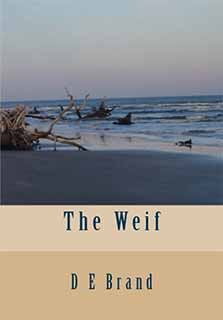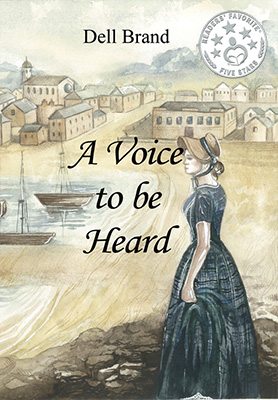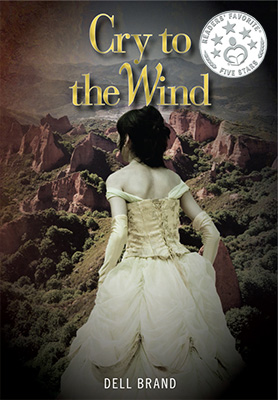THE WEIF
Book Reviews
It was an absolute delight reading Dell Brand’s,THE WEIF..She is a highly-talented story-teller with a style of expression that contributes to the stories always sounding ‘true to life’.Her characters are always convincing and clear-cut.Her very perceptive research shines through in every chapter.
I have no hesitation in recommending this book…if you’re after…A GOOD READ.
Dennis Koks
The Weif by DE Brand is a wondrous historical journey seen through the eyes of the three main characters, set in the mid-19th century. A journey that begins in a troubled Ireland and the overcrowded prisons of England and that transports the reader to the latter years of a British convict state that will soon evolve into the nation we now know as Australia. The story begins with the sentencing of a young Irishman, Will, to a 14-year sentence and transportation to the colonies for an unfortunate lark gone awry. A mere few years later, his younger sister, Lizzie, is sentenced to 7 years for assault when fending off the advances of her employer. Once on board ship, Lizzie is befriended by an older and wiser Bella, forming the beginning of a lifelong friendship.
Ms. Brand’s storytelling of Will’s degradation on board his transport ship to his years in Sydney, to Lizzie’s and Bella’s landing in Van Dieman’s Land (Tasmania) and imprisonment at the infamous Female Factory, reminded me fleetingly, and favorably, of the books within Bryce Courtenay’s exquisite Australian Trilogy. We follow their lives through the years and their ever-changing locales while they happen upon many of embryonic Australia’s more important historical events. Can Will locate his sister? Will Lizzie ever truly escape the ties that bind her? Can an entire people escape their chains and carve out a new and free life? Ms. Brand’s novel is superbly researched. And for those readers looking for a glimpse into the formative years of a nation, The Weif is a fantastic primer.
Reviewed By Neil A White for Readers’ Favorite 4 Stars
The Weif by DE Brand tells the story of a young girl, banished from her homeland at the age of fifteen after she commits a violent act. The book follows her adventures as she starts a new life, determined to mend her ways and succeed in life. She moves to Van Dieman’s Land (Tasmania) where she finds work as a nursery maid, eventually learning a great deal from the family tutor, Percy. She leaves her nursery job and heads for Adelaide to take up a new job as a mistress, but her plans are foiled when the ship is wrecked and she finds herself on the stranger shores of South Australia. Lizzie Darling will settle here to start life anew, opening her own school and gaining the reputation of a respectable teacher, but nothing good seems to last long for her. She’ll have to make a choice between violence and going down indefinitely.
Told in the first person narrative, The Weif is an impassioned story that looks at the highs and lows of one woman’s life, a story that is filled with realism and powerful life lessons. Readers will learn to care about the protagonist, watching as she develops, wondering if she can find redemption. DE Brand is a good storyteller and she allows her Irish culture to come through the narrative. The author masterfully handles great themes like friendship, education, change, and adventure. The internal conflict within the protagonist is well-developed and a great force drives this beautiful story. The Weif is a well-developed and engaging read.
Reviewed By Romuald Dzemo for Readers’ Favorite 5 Stars
In an interesting, emotional and historically accurate new read by author DE Brand, The Weif is a story that will have readers engaged from the very start and will keep them reading obsessively all the way through to the very end. Follow the story of Irish lass Lizzie Darling, who has been banished from her family and Ireland after committing an unspeakable violent act. She finds herself in Hobart Town, working as a nursery maid for the Fletcher family, and even finds a tutor willing to teach her to read and write. But just as things seem to be looking up for the young girl, she finds herself adrift again, on her way to Adelaide. After a shipwreck leaves her stranded with a person who is not as they originally seemed, she fights her way forward to begin a life as a respected teacher on the Victorian gold fields. Life deals her another blow, and she has to resort to violence again. Will she be able to make a life for herself after this turn? You’ll need to read the book to find out!
I very much enjoyed The Weif. Author DE Brand has done an amazing job in creating characters that readers will connect with, relate to and truly come to care about. If that isn’t a hallmark of a great author, I’m not sure what is. The story line is crisp and unique, and moves forward at an excellent pace. The historical details appear to be accurate and really add to the authenticity of the story. I am pleased to be able to highly recommend The Weif and look forward to reading more from author DE Brand in the future!
Reviewed By Tracy Slowiak for Readers’ Favorite 5 Stars
The Weif by DE Brand tells the story of Lizzie Darling, her brother, and Bella. First, Lizzie’s brother is transported to Australia because of a prank that has gone terribly wrong – then Lizzie has to find out that a woman seems to not even have the right to defend herself when a man tries to rape her. For defending herself, she is also convicted as a criminal, and sent off to Australia. On the journey, she meets Bella, who becomes an important person in Lizzie’s life. Lizzie works through her years, earns her ticket of leave, but decides to remain in Australia. Everything seems to go well until fate plays some cruel tricks on the young woman. She has to learn that nothing good seems to last forever, and that cruelty is something that always crosses her path and is used against her – until she decides that she can also be cruel.
While the reader gets to hear the stories of different characters in The Weif by DE Brand, Lizzie is clearly the central character – and deserves to be so, too. She is a woman that is thrown into the deep end many times, and who has to survive in a world in which women still have little to say. The reader is taken back to the time in which convicts were sent to Australia to serve their sentence. We learn a lot about the conditions of the transport and how convicts were really treated in Australia. The historic information is woven into the story in a very smooth manner; you simply can’t help but learn more about that part of history. At the heart of the story, however, is the struggle of one woman for the right to live her life the way she wants to live it. I found the plot became more and more exciting with each chapter, and while I usually do not like woman’s fiction, this one was a really good read!
Reviewed By Kim Anisi for Readers’ Favorite 5 Stars
In general, I enjoyed The Weif. The plot was clear with well-rounded characters and it was easy to get invested in it. The plight of each one of them and how their unjust/harsh sentences affected their lives drew me in right away. It was interesting to see the difference between the treatment of classes: eg. the condemnation of Will as compared to his sister’s attacker.
Unfortunately, I was not fond of the rape scenes. I find that using rape (while it is a reality of life) is an overused trope for creating conflict. Even the rape of Will and his friend seems more gratuitous than something that moves the plot along. Bernie is already depressed and the general abuses and suffering that occurred on the ship seemed more than enough to push him over the edge. I’ve included a couple of links to articles on rape in stories. http://www.telegraph.co.uk/tv/2016/12/07/rape-scenes-have-become-plague-industry-says-hollywood-producer/amp/
https://www.wired.com/2015/06/rape-scenes/Aside from this, for me, the story had moments where it slipped into too much telling as opposed to showing and the dialogue felt wooden at times too.
I also found the dialogue somewhat boring in its presentation. One person speaks/another person speaks. There are no dialogue tags at all (which, I know, is often encouraged in writing circles) but there is also little description or action attached to the dialogue. This tends to feel like listening to a phone call instead of painting a scene one can sink into. There is little to support the dialogue and give body to the scene.
Overall, though, I think the story has plenty of potential. Thanks for the read.
Reviewed By Kris Moger for Readers’ Favorite 3 Stars
Although it was over a year ago that I read the draft for this book, from what I recall of that reading, this final version shows a lot of improvement. I admire Dell’s commitment to detail.
Some aspects of the work and conditions endured by Will and Lizzie highlight the harshness of Australia during the time in which they lived. I especially liked the description of the stone cutting. A couple of years ago a landscaper installed a living wall around our house which incorporates several sandstone pillars, constructed from sandstone left over from old building sites. The labour intensity involved is difficult to appreciate and well depicted in this novel.A note on style: The beginning of the book recalled to me the opening of Long Bay and Life after Life which began with the central character having a trial and/or sent to jail and then recapped the how and why. Sometimes this starts a problem if the reader likes events in chronological order. However it is a good device to get the reader to want to know more about the guilt or other wise of the character.
Belinda Schuster
Very entertaining story of 19th Century Australia – 4 stars
Dell Brand’s The Weif is set primarily in nineteenth century Australia, which, like the United States, was being settled by immigrants from Europe, many as indentured servants. It’s a story of three Irish prisoners sentenced to years in servitude with hopes of being emancipated after serving their terms.Readers first experience this through the eyes of 18-year-old William, who is convinced by friends to embark on a prank which goes badly wrong, resulting in William being sentenced to 14 years of “penal servitude” in Australia. It’s 1836 and William is thrown onto a wooden frigate, crowded with too many men and too many bugs and rats, reeking of rot and decay. He’s beaten and abused by the ship’s bullies. His sister Lizzie takes up the story in 1840 when she’s only 15, working as a maid in a hotel. Fighting off a rapist, she injures her attacker. Being of a lower class, she is sentenced to 7 years.
Lizzy’s transport ship is far less wretched than William’s, perhaps because virtually all the prisoners are women and their children. There she meets Bella, the third character who tells her story in The Weif. As Bella tells it, the female prisoners are all given new clothes to wear and adequate healthcare, whereas the male prisoners were treated worse than animals. But even the women did not have it easy, given the miserable seasickness. Bella is a strong woman, physically and morally, and she is like a big sister to young Lizzie throughout the trip.
The rest of the novel takes place in early Sydney, Melbourne, and more primitive towns. The three main characters take turns relating their adventures, each meeting remarkable people along the way. Some are villains happy to take advantage of the downtrodden prisoners but most do what they can to improve the lives of William, Lizzie and Bella. Lacking the freedom to travel where they wish, the three meet each other only occasionally throughout the novel. As each gains their freedom, their lives intertwine more closely.
The Weif is extremely well-written, imaginative, and entertaining. Each creative episode illustrates different facets of life in south-east Australia from 1840 to 1855. As with the best historical fiction, the main characters mix with actual events and figures. This alone requires deep research, but Ms. Brand goes further, mastering the language of the time and place, nuanced by giving the characters different “voices”. I highly recommend this book to fans of historical fiction and those who wish to learn more about Australia’s early settlers.
Don Westenhaver USA
I read your book and enjoyed it. I liked the way you alternated the stories from the siblings and really appreciated the historical treats of cultural references and events The early part set in Ireland and their journey to Australia I found particularly interesting – that was all new for me. Blending history and narrative is great – keep writing!
Jill Hawthorn









